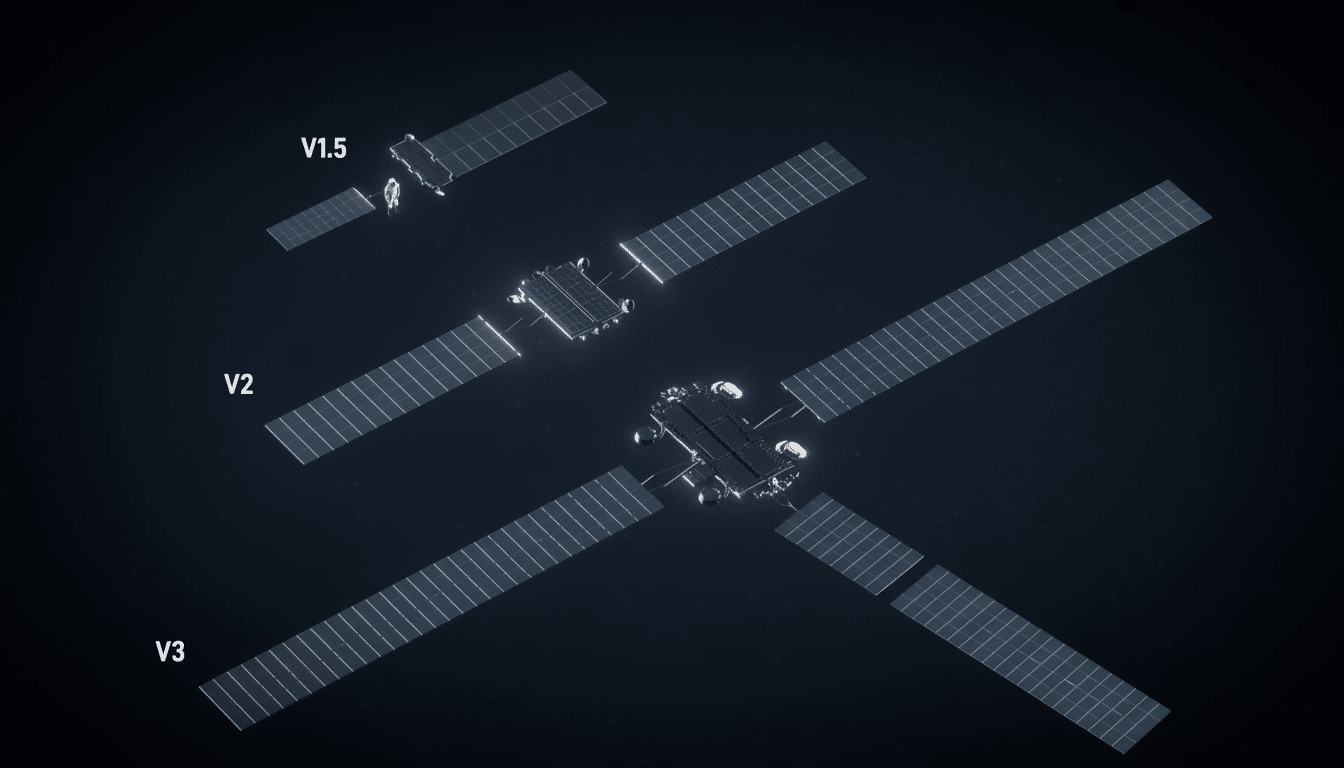SpaceX has given its best look yet at the next-generation Starlink hardware, revealing an even larger V3 satellite internet dish that will enable commercial gigabit-class service and potentially increase network capacity several times over. The teaser, posted during a Starship flight test webcast, gives us a glimpse of just how SpaceX envisions making the leap from today’s Falcon 9–optimized Starlink craft to a heavier, more capable vessel that relies on the company’s still-in-development Starship vehicle for launches.
What the V3 Changes Mean for Design and Capacity
The V3 is significantly longer and mates with larger solar panels, suggesting greater onboard power to support higher-throughput payloads. SpaceX has proposed new phased-array antennas as a cornerstone of multi-gigabit aggregate capacity, with over-the-air beamforming to more effectively manage congested cells and boost peak rates to end users.

Regulatory filings signal a jump in mass, with V3 aiming for around 2,000 kilograms per satellite as opposed to approximately 575 kilograms for the current V2 Mini class riding Falcon 9. By that scale, the company can permit more in-orbit radios, more power and perhaps meatier optical inter-satellite links to transfer traffic across the constellation while avoiding saturated ground backbones.
Each V3, SpaceX has said, is designed to support about 1 terabit per second of total downlink capacity — an order-of-magnitude increase compared with V2 Minis. The company also intends to perform Starship missions with about 60 V3 satellites each. Beyond that, this would inject more than 20 times the capacity per launch compared with Falcon 9 batches, if those numbers align with available operational service data.
Why Starship Is the Key Enabler for V3 Starlink
Payload volume and mass-to-orbit are the practical unlocks for V3 satellites. “Satellites made for Falcon 9 have to miniaturize,” it added, referring to variants that fit payload fairing and weight constraints. V3 flipped the equation: the satellite grows to what the network demands, and the launcher scales up to take it. In a recent test, SpaceX launched several V3 mass simulators to verify separation and operations — a step toward full-up satellite flights.
How soon the V3 capacity will be flying to orbit will depend on how frequently Starships are launched and how reliable they are in service. A high-tempo launch pace would allow SpaceX to clear overburdened areas more quickly and help level out seasonal surges in demand, while opening the door to higher-density markets that have hit spectrum and cell-capacity ceilings.
What Gigabit on Starlink Means for Real Users
“Gigabit” on a shared satellite brings peak attainable speeds, not guaranteed throughput. However, higher aggregate capacity per satellite tends to mean better real-world performance: fewer slowdowns at peak hours, steadier uploads for creators and more headroom for businesses running SD-WAN or low-latency apps. Third-party testing from companies like Ookla has shown Starlink’s median speeds increasing in areas where capacity is added, an improvement that V3 aims to make more consistent.

SpaceX has said that new user hardware will be necessary to achieve gigabit-class speeds. Look for newfangled phased-array dishes with speedier silicon, broader bandwidth support and perhaps even more power draw. Latency should continue to be a strong suit compared with geostationary systems, as LEO orbits keep round-trip times in the tens of milliseconds — which are good enough for cloud apps and competitive gaming when cell load is well-governed.
Capacity matters beyond speed tests. In a number of saturated regions, the corporation just lately began implementing a one-time demand surcharge to new subscribers. An implementation of V3 — paired with more intelligent traffic engineering and optical crosslinks — could make it so these sorts of contingencies are unnecessary by providing real headroom on a per-cell and per-beam basis.
Regulatory Hurdles and the Competitive Context Ahead
SpaceX still needs the Federal Communications Commission to approve additional services and spectrum use associated with its next-generation constellation plan before V3 becomes fully operational. Behind the scenes, that’s in addition to filings through the International Telecommunication Union which dictate coordination, interference limits and debris mitigation — soon-to-be-key considerations as fleets of satellites grow.
The competitive backdrop is intensifying. Amazon’s Project Kuiper has started early deployment, and Eutelsat OneWeb is targeting enterprise and mobility. All are driving towards higher-throughput payloads and larger laser links to reduce the cost of backhaul and improve coverage consistency. SpaceX is betting that if a high-capacity satellite can be paired with a similarly capacious launcher, scale and the speed of deploying gigabit features will allow it to break into the lucrative market for saturated markets with low cost per delivered gigabyte.
What to Watch Next as SpaceX Readies V3 Starlink
Milestones include FCC approvals for V3 operations, a ramping flight cadence for Starship and the onset of mass production at SpaceX’s satellite facilities. On the user side, look for new terminal announcements — antennas optimized for rooftops, RVs and maritime are big sellers on Earth — plus updates to service tiers that leverage the extra capacity.
If SpaceX is able to hit its own targets — of around 1 Tbps per V3, with about 60 satellites going up in every Starship flight — the cumulative effect could mean a step-change improvement in Starlink’s per-beam performance and availability. The company has established that there is demand; V3 is its response to supply.

